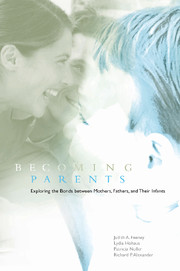Book contents
- Frontmatter
- Contents
- Preface
- 1 The Transition to Parenthood
- 2 Attachment in Childhood and Beyond
- 3 The Study
- 4 The Couples
- 5 Pregnancy and Plans for Birth
- 6 Couples' Experiences of Birth and New Parenthood
- 7 How Does New Parenthood Affect Couples?
- 8 Dealing with Depression
- 9 Men, Women, and Household Work: The Diaries
- 10 Couples' Changing Attachment Relationships
- 11 Six Months into Parenting
- 12 New Parenthood in Perspective
- Appendix A Core Questionnaires Completed by Couples
- Appendix B Summary of Sample Characteristics
- Appendix C Summary of Major Statistical Analyses
- References
- Author Index
- Subject Index
10 - Couples' Changing Attachment Relationships
Published online by Cambridge University Press: 05 June 2012
- Frontmatter
- Contents
- Preface
- 1 The Transition to Parenthood
- 2 Attachment in Childhood and Beyond
- 3 The Study
- 4 The Couples
- 5 Pregnancy and Plans for Birth
- 6 Couples' Experiences of Birth and New Parenthood
- 7 How Does New Parenthood Affect Couples?
- 8 Dealing with Depression
- 9 Men, Women, and Household Work: The Diaries
- 10 Couples' Changing Attachment Relationships
- 11 Six Months into Parenting
- 12 New Parenthood in Perspective
- Appendix A Core Questionnaires Completed by Couples
- Appendix B Summary of Sample Characteristics
- Appendix C Summary of Major Statistical Analyses
- References
- Author Index
- Subject Index
Summary
“After the baby was born, I did feel different. Like we're a family, and the love's split three ways now.”
A central theme of this book is the importance of attachment relationships, that is, close relationships that play a special role in meeting needs for comfort and emotional security. In this chapter, we explore the nature of couples' attachment relationships throughout the transition to parenthood. We focus on two broad issues related to attachment bonds. First, we look at the importance of attachment relationships with spouses, friends, and family members, including comparisons across the two groups of couples and across the three major phases of the study. Second, for transition couples, we examine the development of the new parents' sense of attachment to their babies.
RELATIONSHIPS WITH SPOUSES, FRIENDS, AND FAMILY MEMBERS
As we noted in Chapter 2, there has been a growing recognition by relationship researchers that needs for comfort and security are universal, and evident at all stages of the life span. In other words, both children and adults have “attachment figures,” who play a special role in their lives. For this reason, we asked couples to name their attachment figures (or “most important people”) at each of the three main assessment points. We were interested in finding out which people they saw as central to meeting their needs for comfort and emotional security, and how this attachment network might change across the transition to parenthood.
- Type
- Chapter
- Information
- Becoming ParentsExploring the Bonds between Mothers, Fathers, and their Infants, pp. 163 - 179Publisher: Cambridge University PressPrint publication year: 2001

